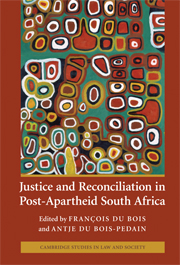Book contents
- Frontmatter
- Contents
- List of tables and figures
- List of contributors
- Acknowledgements
- List of abbreviations
- Introduction
- 1 Reconciliation as surrender: configurations of responsibility and memory
- 2 Radical forgiveness: transforming traumatic memory beyond Hannah Arendt
- 3 Communicating criminal and political responsibility in the TRC process
- 4 The contribution of criminal justice
- 5 Reparation and the forms of justice
- 6 Land restitution and reconciliation in South Africa
- 7 For justice and reconciliation to come: the TRC archive, big business and the demand for material reparations
- 8 Transition, forgiveness and citizenship: the TRC and the social construction of forgiveness
- 9 The evolving legitimacy of the South African Constitutional Court
- 10 Drawing the line: justice and the art of reconciliation
- 11 Post-conflict justice and the reconciliatory paradigm: the South African experience
- Index
- References
4 - The contribution of criminal justice
Published online by Cambridge University Press: 01 July 2009
- Frontmatter
- Contents
- List of tables and figures
- List of contributors
- Acknowledgements
- List of abbreviations
- Introduction
- 1 Reconciliation as surrender: configurations of responsibility and memory
- 2 Radical forgiveness: transforming traumatic memory beyond Hannah Arendt
- 3 Communicating criminal and political responsibility in the TRC process
- 4 The contribution of criminal justice
- 5 Reparation and the forms of justice
- 6 Land restitution and reconciliation in South Africa
- 7 For justice and reconciliation to come: the TRC archive, big business and the demand for material reparations
- 8 Transition, forgiveness and citizenship: the TRC and the social construction of forgiveness
- 9 The evolving legitimacy of the South African Constitutional Court
- 10 Drawing the line: justice and the art of reconciliation
- 11 Post-conflict justice and the reconciliatory paradigm: the South African experience
- Index
- References
Summary
INTRODUCTION
In dealing with its apartheid past, South Africa took the position: We need not punish the perpetrators, but we must know the truth. The resultant combination of a victim-centred truth commission with the granting of individual amnesties on the basis of full disclosure has been praised as an innovative alternative to the prosecutorial approach to past injustices.
This chapter seeks to analyse the contribution of the criminal justice system to the amnesty process. It argues that this contribution has at least three dimensions. The first of these is a limiting one: the amnesty process mirrored certain aspects of the criminal justice system and thereby, in a sense, reaffirmed the apartheid legal order. This may explain some of the shortcomings of the process. The second dimension is complementary: ongoing investigations and prosecutions of apartheid crimes uncovered information and provided an accountability mechanism running parallel to that constituted by the amnesty process. The third dimension is interactive. During the lifetime of the Truth and Reconciliation Commission (TRC), the criminal justice system played a crucial role in making perpetrators come forward and apply for amnesty. This dimension remains important after the conclusion of the TRC's work, for the prosecution of those who did not seek, or were found not to qualify for, amnesty is essential to the integrity and credibility of the amnesty scheme.
- Type
- Chapter
- Information
- Justice and Reconciliation in Post-Apartheid South Africa , pp. 90 - 115Publisher: Cambridge University PressPrint publication year: 2009
References
- 1
- Cited by

